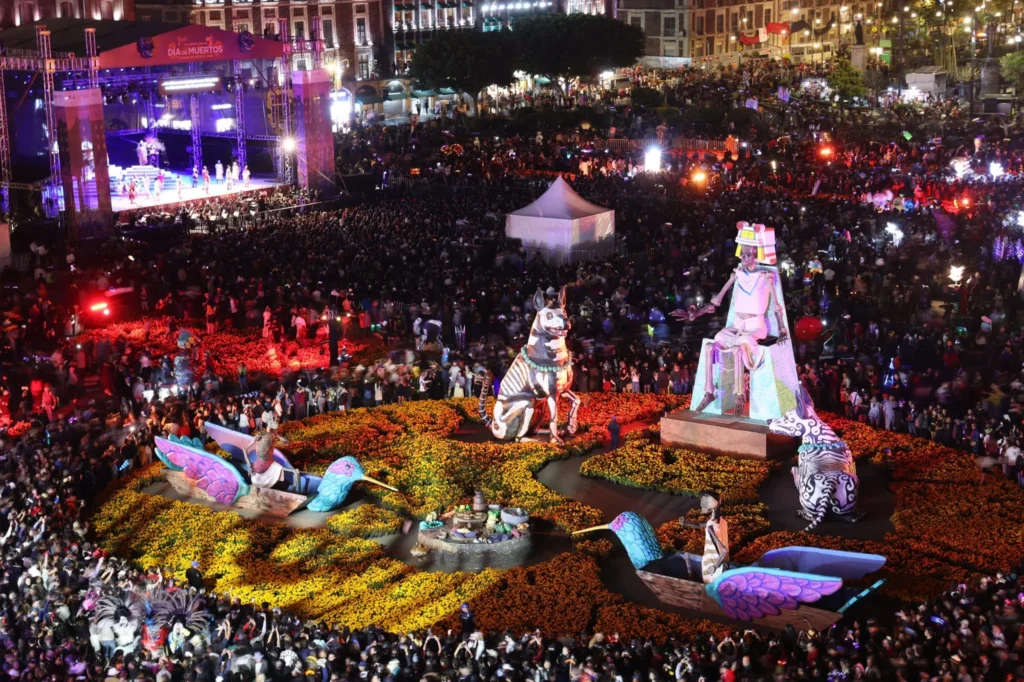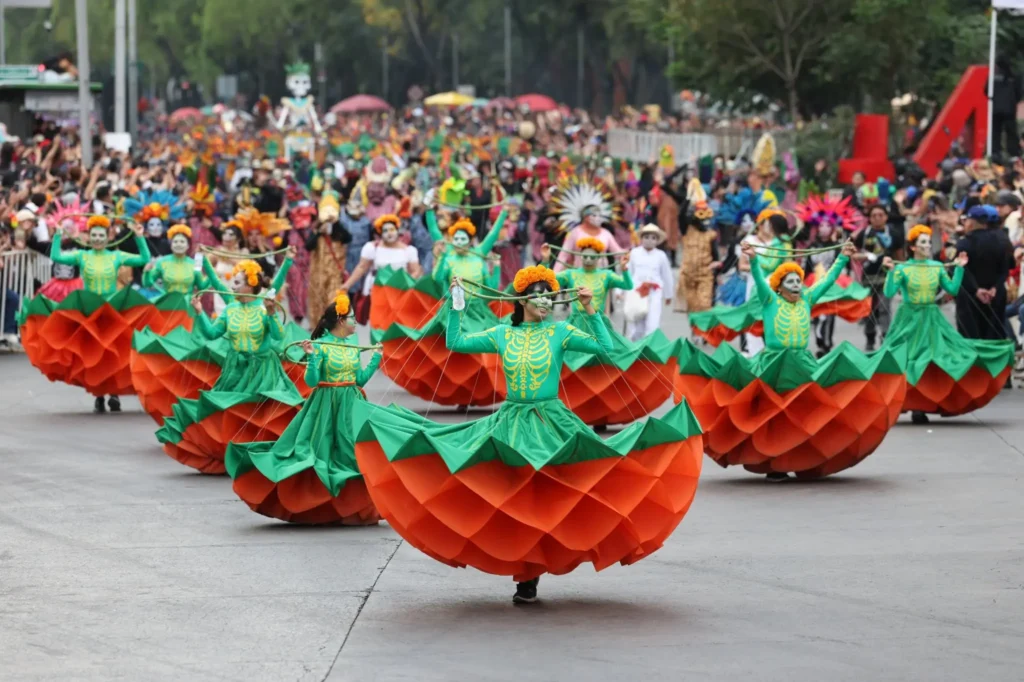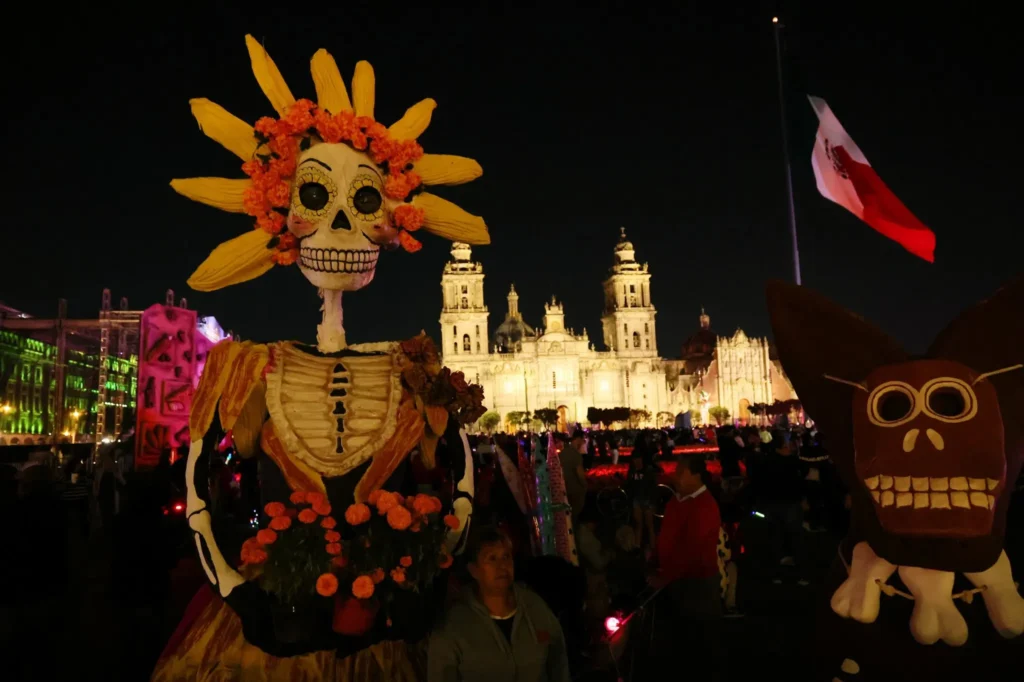Bathed in cempasúchil flowers, music, and ancestral symbolism, Mexico’s capital witnessed one of the largest Día de Muertos celebrations in its history, drawing more than 7.5 million people, according to data released by the Government of Mexico City.

Residents and visitors filled streets, plazas, and landmarks with color and remembrance in a celebration that blended art, tradition, and collective identity.
At the heart of the festivities, the Monumental Ofrenda in the Zócalo became a major attraction, welcoming 1.5 million visitors. The massive installation — adorned with thousands of marigold flowers, traditional skulls, and figures inspired by Mexica cosmology — featured a striking xoloitzcuintle sculpture, representing the guardian dog that guides souls to the afterlife, capturing the admiration of the crowd.
The Procession of the Catrinas, one of the most beloved traditions, gathered over 1.2 million people along Paseo de la Reforma, while the Grand Day of the Dead Parade 2025, held on November 1, drew a crowd of 1.45 million.
The parade featured floats, dancers, musicians, and artists honoring Mexico’s deep-rooted relationship with death, memory, and celebration.

According to the city’s official report, the holiday weekend also featured the Zombie Walk, which brought together 120,000 participants, and the “Night of the Dead” Night Ride, where 190,000 cyclists, skaters, and pedestrians toured a city glowing with light and life.
The Territories of Peace and Equality program mobilized 35,000 people in community activities focused on art, sports, and nonviolence, reinforcing the spirit of unity and inclusion that defines the celebration.
In six city municipalities — Xochimilco, Iztapalapa, Azcapotzalco, Gustavo A. Madero, Cuauhtémoc, and Tláhuac — monumental altars attracted thousands of families, turning public spaces into living tributes to Mexico’s cultural heritage.
Meanwhile, the festival “Me muero por bailar” (“I’m Dying to Dance”) gathered over 5,000 participants, celebrating dance, creativity, and collective well-being.
The Cempasúchil Fair, held along Paseo de la Reforma, welcomed 317,000 visitors, generating an economic impact of 101.7 million pesos (US$5.47 million) and the sale of 5.96 million flowers.
According to the local government, the event directly benefited 460 farming families from Xochimilco, Tláhuac, and Milpa Alta, reaffirming the marigold’s role as both a cultural emblem and a vital source of local income.
The Festival of Lights, which illuminated the Historic Center in downtown Mexico City and major avenues, attracted 2.5 million spectators, while the Parade of Monumental Alebrijes, organized by the Museum of Popular Art, drew 158,000 attendees and featured over 120 troupes, floats, and giant catrinas.
As part of the cultural programming, three open-air performances of the opera Cuauhtemotzin were staged in the Plaza de la Constitución, gathering 15,000 people and reinforcing the Zócalo’s role as the cultural heart of the capital.
In San Andrés Mixquic, located in the municipality of Tláhuac, more than 10,000 visitors took part in the traditional celebrations of this emblematic outlying municipality, famous for its candlelit cemetery vigils — one of Mexico’s most moving and authentic Day of the Dead traditions.
With these record-breaking numbers, Día de Muertos 2025, as reported by the Mexico City government, reaffirms its place as one of the world’s most powerful cultural expressions — a celebration where memory, music, and color intertwine to honor those who are gone but never forgotten.

Related: Pan de Muerto: an Offering that Unites the Soul, the Earth, and the Flavor of Mexico
Mexican Press Agency is part of ALMA, which is dedicated to news and information about Mexico and Mexicans in the United States and is a fiscally sponsored project of Social Focus, a 501(c)(3) nonprofit organization based in Redwood City, California.